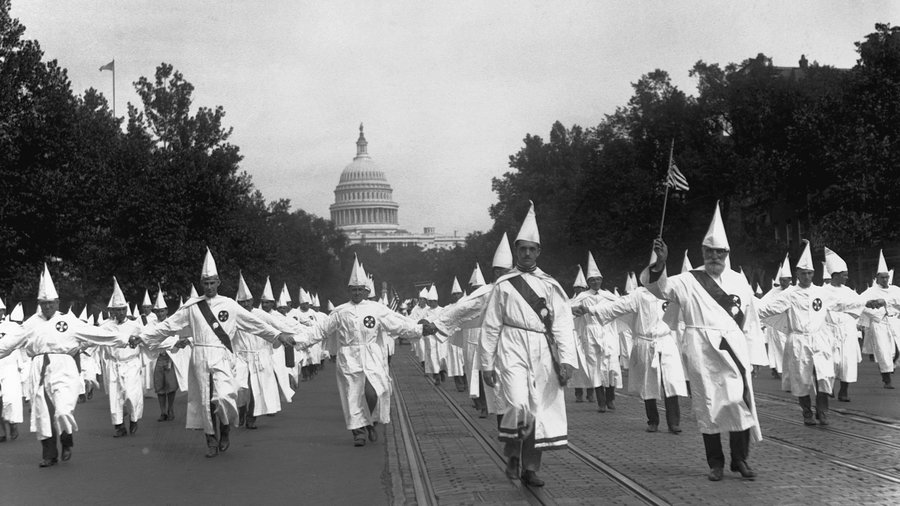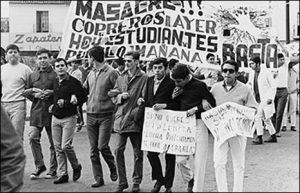Since its origins, the infamous Ku Klux Klan has influenced the attitudes and views of many Americans. The KKK will forever be recognized as the largest political hate group in United States history. Despite the rise and fall of the Klan, it wasn’t until the 1920s that it rose to its highest peak in prominence. During this time period, there was exponential growth in both membership in and support for this notorious cult. The KKK was a growing cult in the 1920s because it instilled religious beliefs, terror, and a skewed view of a better America into the minds of its members through its propaganda of racial superiority.
The original KKK arose during the Reconstruction era of the 1860s and 1870s, and was primarily aimed at restoring the antebellum racial hierarchy to the South. However, it declined in the 1870s due to the passing of legislation aimed at stopping Klansmen’s voter intimidation activities and associated hate crimes. With the end of Reconstruction in 1877, and the passage of Jim Crow laws throughout the South, Klan activity and Klan membership declined. But the cult began a strong resurgence in 1915, with membership skyrocketing to nearly four million by the year 1920.1 This time, the focus of their efforts was aimed at “Americanizing” people by promoting the Constitution, the flag, and the Bible.2 This white supremacist organization lashed out at any group whose ideals conflicted with their own, especially that of African Americans, Catholics, and Jews.

The revival of the Klan was led by its notorious second Grand Wizard (the KKK’s primary leader), William J. Simmons, who was a preacher, a veteran, and an extreme white supremacist.3 He was inspired to reorganize the Klan after watching the silent movie Birth of a Nation, which depicted the Klan as a saving grace, defending the birthright of white southerners and greatly enhancing the public opinion of the cult.4 The religious implications of the KKK stemmed from the teachings of Simmons. Not only were his sermons effective at grasping the hateful minds of Klan members, but he truly convinced them that they were doing the work of God; his credibility led him to a position of power. In fact, one could not join the Klan unless one practiced “militant Christianity,” living in such a way as to be an example to others by following laws, abstaining from drinking, gambling, infidelity, and by not neglecting one’s family. Members were to attend church services regularly, always adhering to the foundations of the Christian faith.5 In addition to this, the KKK burned crosses, often arguing that it was to symbolize the spread of Jesus’ light; it was a symbol aimed to “drive away darkness and gloom.”6 The heavily emphasized morals and negative attitudes toward others are what drove the cult’s frame of thought. Often interpreted in a hateful manner, the religious implications instilled by the KKK’s leaders too often brewed inaccurate thoughts in the minds of its followers; thus, many assumed that the answer to their problem was to commit radical acts of terror.

In addition to their cloaking themselves in the trappings of Christianity, the Klan also used terror tactics to instill fear into both its own members and to those it targeted. The members saw themselves as vigilantes in the restoration of justice—using intimidation, violence, and terror to prevent people of color from attaining any sort of social status or political power. They burned crosses, led beatings, committed assassinations, lynchings, and much more.7 While the symbol of the KKK, the burning cross, held religious connotations for its own members, it was also used as a form of intimidation. They used this symbol of a burning cross to terrorize African Americans.8 In addition to intimidating African Americans, the Klan also targeted Catholics, and had a particularly strong concern with this group due to the fact that they practiced a “different religion” from their own. The motivation for this anti-Catholicism is deeply rooted in American history, going all the way back to colonial times. And with the dramatic increase of Catholics immigrating from Ireland, Italy, and Germany in the nineteenth century, anti-Catholicism was a mainstay throughout American life in the early decades of the twentieth century.9 With the ethnic, social, and racial diversity of American life, tensions continued to heighten among the opposing whites who sought to rid America of these many “outsiders” — a long-held notion in American society. In using both verbal and physical threats, the terror inflicted by the cult caused people to fear the power of the invisible empire that was the KKK.
The idea of creating a better America was yet another reason for the Klan’s rise to prominence in the 1920s. The KKK fought for stricter enforcement of prohibition laws, sought to eliminate political corruption, and wanted to eradicate any form of immigration. Any seemingly “foreign-born” citizen that crossed the path of a klansman was deemed un-American. The Klan assumed they were doing the nation its due diligence in suppressing these “outsiders.” At its peak, the Klan even managed to get political leaders to seek their support and endorsement, since many Americans at this time sympathized with the Klan and its mission.10 And as membership grew, so did their influence. Their opposition to non-whites and to immigration helped to secure the passage of strict quotas on those seeking to come to America.11 The KKK was influential in more ways than one — their power reigning heavily on American society. Even today, white supremacists seek to have their voices heard and their views seen as legitimate. The fight for racial toleration is certainly far from over.

On the other hand, some say that the resurgence of the KKK in the 1920s was due primarily to the effects of industrialization, urbanization, and immigration on society. White Americans became uneasy about immigration and “outsiders” taking American jobs. Many could not stand the idea of “those people” diluting the “racial purity” of American society. But the idea of racial purity is a myth–yet a strong one that many white racists wish to be true. The original soil of America was populated by immigrants and natives alike; whites simply claimed it as their own, as they were to be the guardians of a “city on a hill” and as part of their “manifest destiny” to be the bearers of a supreme culture and society.12 Those that looked to this cult to justify their own beliefs do not parallel with what it means to be an independent individual in American society. The people they were trying to drive out had just as much freedom to be in the United States as they did. Others in support of the Klan also claimed that Simmons was, in fact, preaching for the betterment of society, and that he never resorted to violence to solve problems; though this may seem true, Simmons was actually insinuating his own, twisted version of the word of God, often emphasizing ideas of white supremacy and racial segregation as if that was God’s will. In a pamphlet he wrote in the early nineteenth century, he even states that the primary goal of the organization is to preserve ideals of pure Anglo-Saxon civilization, and many claimed he preached themes of being a pro-American leader by hinting in his sermons that any person in opposition to traditional thought of Anglo supremacy was unwelcome, and simply un-American.13 He silently, yet deviously, instilled discrimination into the Klan’s members. It was even noted that Catholic priests, Protestant ministers, and Jewish rabbis came forward to condemn the organization and its false teachings.14 It seems that the religious implications, terroristic acts, and the skewed ideals used in order to insinuate the making of a better America are contradictory to both the Klan’s mission and the symbols they claimed to uphold.
With a religious basis, the Klan movement emphasized legal and political approaches to solving the “moral crisis” in 1920s America.15 The cult rose to prominence in the 1920s because of their religious, terroristic, and “ideal American” implications; however, their resurgence only served as a detriment. The second coming of the Klan was significant in that it rose to its highest peak in prominence. The KKK’s second coming only continued to fuel the long-held idea of hatred and discrimination that still lingers in the minds of many today.
- Khan Academy, 2016, s.v. “The Reemergence of the KKK,” by Dr. Michelle Getchell. ↵
- David A. Horowitz, Inside the Klavern: The Secret History of a Ku Klux Klan of the 1920s (Carbondale: Southern Illinois University Press, 1999), 10. ↵
- David A. Horowitz, Inside the Klavern: The Secret History of a Ku Klux Klan of the 1920s (Carbondale: Southern Illinois University Press, 1999), 11. ↵
- Roland G. Fryer, “Hatred and Profits: Under the Hood of the Ku Klux Klan,” Quarterly Journal of Economics 127, no. 4 (November 2012): 12. ↵
- Holley Donald, “A Look Behind the Masks: The 1920s Ku Klux Klan in Monticello, Arkansas,” The Arkansas Historical Quarterly no. 2 (2001): 19. ↵
- David Cunningham, “Top 5 Questions About the KKK,” PBS, 2013. Accessed March 12, 2018. http://www.pbs.org/wgbh/americanexperience/features/klansville-faq/. ↵
- Khan Academy, 2016, s.v. “The Reemergence of the KKK,” by Dr. Michelle Getchell. ↵
- PBS, 2013, s.v. “Top 5 Questions About the KKK,” by David Cunningham. ↵
- Mark Paul Richard, Not a Catholic Nation: The Ku Klux Klan Confronts New England in the 1920s (Amherst: University of Massachusetts Press, 2015), 11. ↵
- American Decades, 2001, s.v. “After the Great War: Nativism and the Ku Klux Klan,” by Judith S. Baughman, et.al. ↵
- Gale Encyclopedia of American Law, 2011, s.v. “Ku Klux Klan,” by Donna Batten. ↵
- Khan Academy, 2016, s.v. “The Reemergence of the KKK,” by Dr. Michelle Getchell. ↵
- William J. Simmons, “Pamphlet for the Ku Klux Klan Written by Colonel William Joseph Simmons,” Smithsonian, 2017. Accessed April 6, 2018. https://nmaahc.si.edu/object/nmaahc_2011.155.15. ↵
- Khan Academy, 2016, s.v. “The Reemergence of the KKK,” by Dr. Michelle Getchell. ↵
- Holley Donald, “A Look Behind the Masks: The 1920s Ku Klux Klan in Monticello, Arkansas,” The Arkansas Historical Quarterly no. 2 (2001): 14-15. ↵




122 comments
Andrea Tapia
This was a good article to read because no one really talks about what the KKK did that was so wrong in our society. I really enjoyed learning more about not only their views on life, but I wasn’t aware that African Americans weren’t their only target. They also disliked Catholics and Jews because they didn’t like people who believed in a different religion. Even when they would burn crosses to represent the light of Jesus and dressed up really confused me on how this would shape a better America. Especially because of so much hate they spreaded, but still believed in God and went to church like many others. While they treated people of color bad and did believe that they were doing this work for God. Even after today we still see white supremacists and always wonder how life would be if we each treated one another equally. To be able to create a better future and world for us to live in from people being affected by not only the KKK but others as well.
Maggie Trujillo
Interesting article about the Ku Klux Klan (KKK). While reading this article, I found it ironic how they built the KKK on the foundation of religion and to practice Christianity when they are known as the largest political hate group. Another interesting thing that I learned from this article was the reason they (KKK) burned crosses. It stated that they burned crosses was to spread Jesus light and to scare away darkness and gloom. However, it was the reason of why I thought they did burn crosses that everyone remembers – to intimidate and do extreme acts of violence on anyone who did not fall in line with their beliefs or religion.
Ian Poll
The KKK had very conflicting motives and actions. They used the idea of religion and fear in order to keep people in line, but also threatened and killed people of color and used their religion as a reason to do so. They were led by misguided information and manipulated information to form an echo chamber of self-righteousness and when thinking or being told otherwise, would be seen as unamerican.
Danielle Rangel
This article does a great job of telling the history of the Ku Klux Klan. It is interesting how the KKK used things like religion and racial superiority in order to justify their violence and hate. And what is even more interesting is how the fluctuations of membership were affected by the laws and regulations seen in the US. Overall this article does a great job telling how the KKK was able to gain and keep its members during that time.
Bryon Haynes
The idea of the Klan being displayed in the earliest roots of Cinema is something unexpected, especially when knowing it’s that film that reinvigorated the KKK to new heights. The false Religious beliefs and practices aren’t new and didn’t spawn from the Klan proving that past evils are perpetuated through the group and that’s the only thing they achieve successfully.
Nathaniel Liveris
Very good article! I found the inseparable nature of the Klan and Christian worship to be the most sinister part of the organization itself, and the fact that it grew as large as it did was very surprising to me. The acts of terrorism and violence justified by its version of Christian doctrine would sound absurd if it didn’t happen in real life. The whole article really put into perspective how influential this group was and how its downfall saved thousands, if not millions, of lives.
Katarina Sanchez
The majority of everyone has heard about the Ku Klux Klan and about their ignorant views on anyone who wasn’t like them. This article has brought to my attention how easy it is to start any sort of movement, even if spreading hatred is the main goal, sadly. I certainly don’t doubt that the people that led and were spokespeople for the Klan had to have been very persuasive to have so many people believe that their way was the right way and the only right way to live, it is saddening that they couldn’t use their talents to help to spread a more positive message. It is also quite shocking that one of the guides they used to help support their views was Christianity despite every one of their actions had gone against their faith. Sadly to say, that in this world there is always going to be some type of hate. With the KKK still being around and continuing to be such a hateful movement, I can only wish that people who have such ignorant views will have a change in perspective and see that hate eats away at the soul. That there is no point in being so cruel to others just because they have different views or were born different.
Karlo Collazo
I really liked how you give clear points about the history of the arising group named the “KKK.” I found it interesting as you go through some tactics the KKK used to gain superiority against the groups of people they discriminated against. With an informative writing style, you allow the reader gets a detailed depiction of the terrors that the KKK reigned on people, which is just chilling to read throughout the article.
Veronica Lopez
Good article! I found it very informative. I believe the KKK is a taboo topic in America. I don’t really see anyone talk about this particular group and I believe that we should. There’s a lot of things that I didn’t know about the KKK that I think would be educational to people who don’t really the history of the KKK. For example, how the group started and why they did the horrific things they did.
Andrew Molina
I thought the article was very informative and really shed light on the KKK, both the old and new and really show there doctrines of beliefs so to say. I had knew that the KKK were a thing post civil war era, but I never really new that they kind went a way after that period and made a resurgence during the 20th century and came back with more topics and ideas that sparked more hate then there original counterpart. It’s crazy how such a hateful and despicable group can preach the word of God and tell its followers to live by it while at the same time, showing so much hate to others. I feel the article did a good job of portraying there beliefs and ideas, well done.